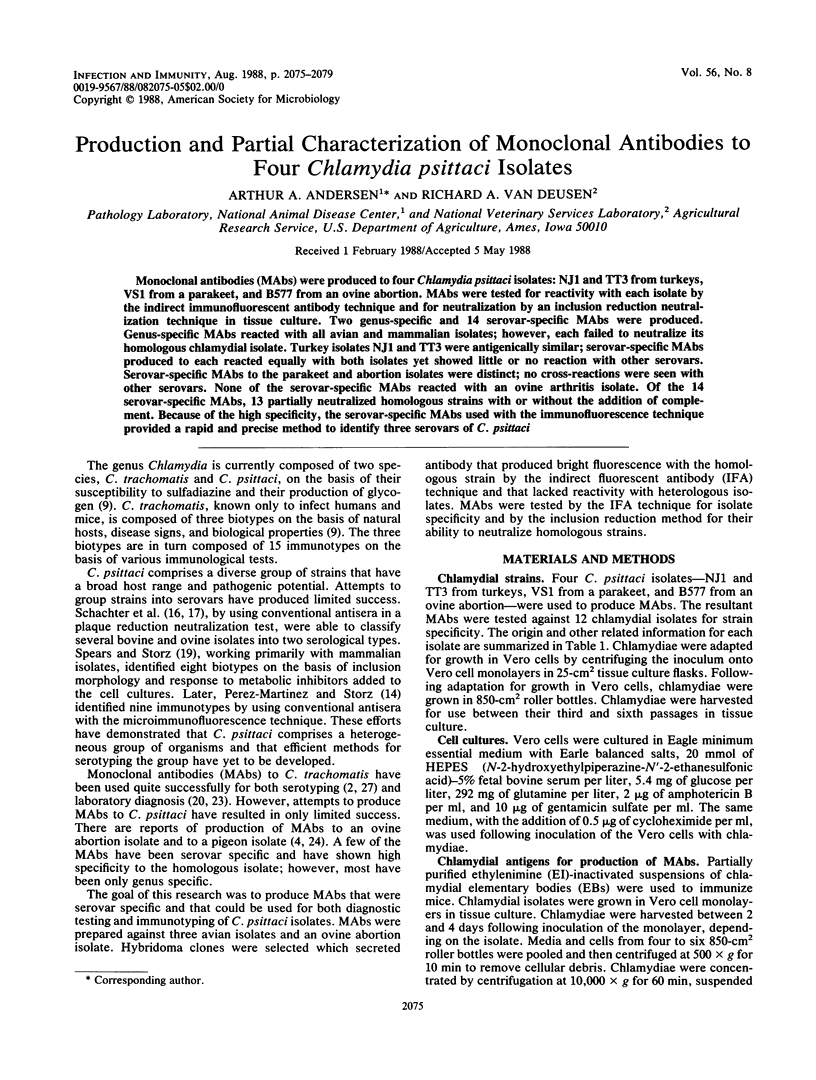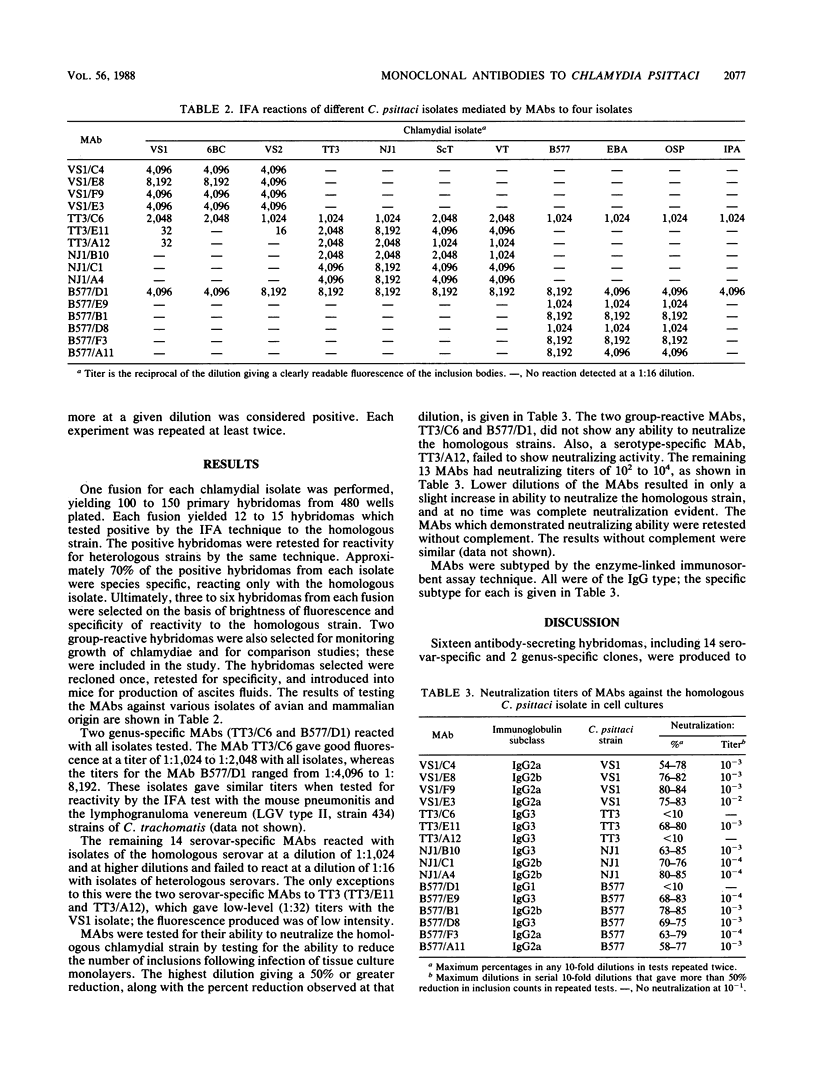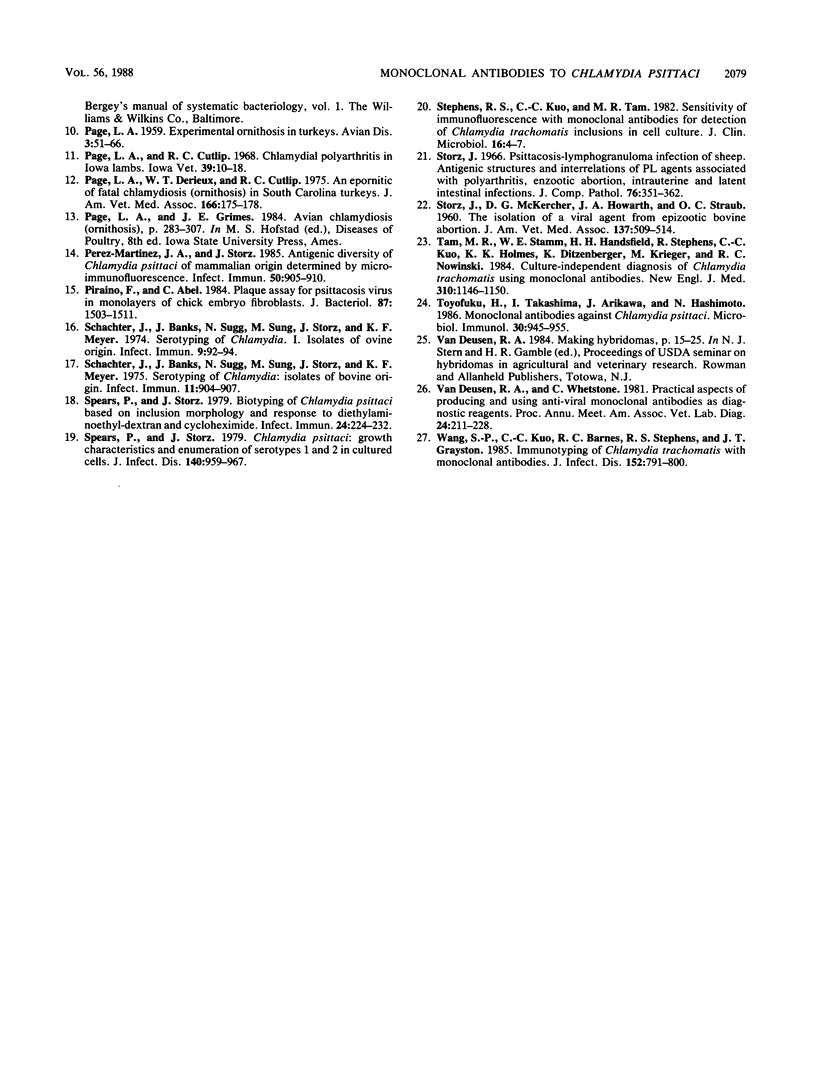Abstract
Monoclonal antibodies (MAbs) were produced to four Chlamydia psittaci isolates: NJ1 and TT3 from turkeys, VS1 from a parakeet, and B577 from an ovine abortion. MAbs were tested for reactivity with each isolate by the indirect immunofluorescent antibody technique and for neutralization by an inclusion reduction neutralization technique in tissue culture. Two genus-specific and 14 serovar-specific MAbs were produced. Genus-specific MAbs reacted with all avian and mammalian isolates; however, each failed to neutralize its homologous chlamydial isolate. Turkey isolates NJ1 and TT3 were antigenically similar; serovar-specific MAbs produced to each reacted equally with both isolates yet showed little or no reaction with other serovars. Serovar-specific MAbs to the parakeet and abortion isolates were distinct; no cross-reactions were seen with other serovars. None of the serovar-specific MAbs reacted with an ovine arthritis isolate. Of the 14 serovar-specific MAbs, 13 partially neutralized homologous strains with or without the addition of complement. Because of the high specificity, the serovar-specific MAbs used with the immunofluorescence technique provided a rapid and precise method to identify three serovars of C. psittaci.
Full text
PDF




Selected References
These references are in PubMed. This may not be the complete list of references from this article.
- BOVARNICK M. R., MILLER J. C., SNYDER J. C. The influence of certain salts, amino acids, sugars, and proteins on the stability of rickettsiae. J Bacteriol. 1950 Apr;59(4):509–522. doi: 10.1128/jb.59.4.509-522.1950. [DOI] [PMC free article] [PubMed] [Google Scholar]
- Banks J., Eddie B., Sung M., Sugg N., Schachter J., Meyer K. F. Plaque reduction technique for demonstrating neutralizing antibodies for Chlamydia. Infect Immun. 1970 Oct;2(4):443–447. doi: 10.1128/iai.2.4.443-447.1970. [DOI] [PMC free article] [PubMed] [Google Scholar]
- Barnes R. C., Wang S. P., Kuo C. C., Stamm W. E. Rapid immunotyping of Chlamydia trachomatis with monoclonal antibodies in a solid-phase enzyme immunoassay. J Clin Microbiol. 1985 Oct;22(4):609–613. doi: 10.1128/jcm.22.4.609-613.1985. [DOI] [PMC free article] [PubMed] [Google Scholar]
- DeLong W. J., Magee W. E. Distinguishing between ovine abortion and ovine arthritis Chlamydia psittaci isolates with specific monoclonal antibodies. Am J Vet Res. 1986 Jul;47(7):1520–1523. [PubMed] [Google Scholar]
- Eb F., Orfila J. Serotyping of Chlamydia psittaci by the micro-immunofluorescence test: isolates of ovine origin. Infect Immun. 1982 Sep;37(3):1289–1291. doi: 10.1128/iai.37.3.1289-1291.1982. [DOI] [PMC free article] [PubMed] [Google Scholar]
- HAHON N., NAKAMURA R. M. QUANTITATIVE ASSAY OF PSITTACOSIS VIRUS BY THE FLUORESCENT CELL-COUNTING TECHNIQUE. Virology. 1964 Jun;23:203–208. doi: 10.1016/0042-6822(64)90283-1. [DOI] [PubMed] [Google Scholar]
- Larghi O. P., Savy V. L., Nebel A. E., Rodriguez A. Ethylenimine-inactivated rabies vaccine of tissue culture origin. J Clin Microbiol. 1976 Jan;3(1):26–33. doi: 10.1128/jcm.3.1.26-33.1976. [DOI] [PMC free article] [PubMed] [Google Scholar]
- Lucero M. E., Kuo C. C. Neutralization of Chlamydia trachomatis cell culture infection by serovar-specific monoclonal antibodies. Infect Immun. 1985 Nov;50(2):595–597. doi: 10.1128/iai.50.2.595-597.1985. [DOI] [PMC free article] [PubMed] [Google Scholar]
- PIRAINO F., ABEL C. PLAQUE ASSAY FOR PSITTACOSIS VIRUS IN MONOLAYERS OF CHICK EMBRYO FIBROBLASTS. J Bacteriol. 1964 Jun;87:1503–1511. doi: 10.1128/jb.87.6.1503-1511.1964. [DOI] [PMC free article] [PubMed] [Google Scholar]
- Page L. A., Derieux W. T., Cutlip R. C. An epornitic of fatal chlamydiosis (ornithosis) in South Carolina turkeys. J Am Vet Med Assoc. 1975 Jan 15;166(2):175–178. [PubMed] [Google Scholar]
- Perez-Martinez J. A., Storz J. Antigenic diversity of Chlamydia psittaci of mammalian origin determined by microimmunofluorescence. Infect Immun. 1985 Dec;50(3):905–910. doi: 10.1128/iai.50.3.905-910.1985. [DOI] [PMC free article] [PubMed] [Google Scholar]
- Schachter J., Banks J., Sugg N., Sung M., Storz J., Meyer K. F. Serotyping of Chlamydia. I. Isolates of ovine origin. Infect Immun. 1974 Jan;9(1):92–94. doi: 10.1128/iai.9.1.92-94.1974. [DOI] [PMC free article] [PubMed] [Google Scholar]
- Schachter J., Banks J., Sugg N., Sung M., Storz J., Meyer K. F. Serotyping of Chlamydia: isolates of bovine origin. Infect Immun. 1975 May;11(5):904–907. doi: 10.1128/iai.11.5.904-907.1975. [DOI] [PMC free article] [PubMed] [Google Scholar]
- Spears P., Storz J. Biotyping of Chlamydia psittaci based on inclusion morphology and response to diethylaminoethyl-dextran and cycloheximide. Infect Immun. 1979 Apr;24(1):224–232. doi: 10.1128/iai.24.1.224-232.1979. [DOI] [PMC free article] [PubMed] [Google Scholar]
- Spears P., Storz J. Chlamydia psittaci: growth characteristics and enumeration of serotypes 1 and 2 in cultured cells. J Infect Dis. 1979 Dec;140(6):959–967. doi: 10.1093/infdis/140.6.959. [DOI] [PubMed] [Google Scholar]
- Stephens R. S., Kuo C. C., Tam M. R. Sensitivity of immunofluorescence with monoclonal antibodies for detection of Chlamydia trachomatis inclusions in cell culture. J Clin Microbiol. 1982 Jul;16(1):4–7. doi: 10.1128/jcm.16.1.4-7.1982. [DOI] [PMC free article] [PubMed] [Google Scholar]
- Storz J. Psittacosis-lymphogranuloma infection of sheep. Antigenic structures and interrelations of PL agents associated with polyarthritis, enzootic abortion, intrauterine and latent intestinal infections. J Comp Pathol. 1966 Oct;76(4):351–362. doi: 10.1016/0021-9975(66)90055-7. [DOI] [PubMed] [Google Scholar]
- Tam M. R., Stamm W. E., Handsfield H. H., Stephens R., Kuo C. C., Holmes K. K., Ditzenberger K., Krieger M., Nowinski R. C. Culture-independent diagnosis of Chlamydia trachomatis using monoclonal antibodies. N Engl J Med. 1984 May 3;310(18):1146–1150. doi: 10.1056/NEJM198405033101803. [DOI] [PubMed] [Google Scholar]
- Toyofuku H., Takashima I., Arikawa J., Hashimoto N. Monoclonal antibodies against Chlamydia psittaci. Microbiol Immunol. 1986;30(10):945–955. doi: 10.1111/j.1348-0421.1986.tb03025.x. [DOI] [PubMed] [Google Scholar]
- Wang S. P., Kuo C. C., Barnes R. C., Stephens R. S., Grayston J. T. Immunotyping of Chlamydia trachomatis with monoclonal antibodies. J Infect Dis. 1985 Oct;152(4):791–800. doi: 10.1093/infdis/152.4.791. [DOI] [PubMed] [Google Scholar]


